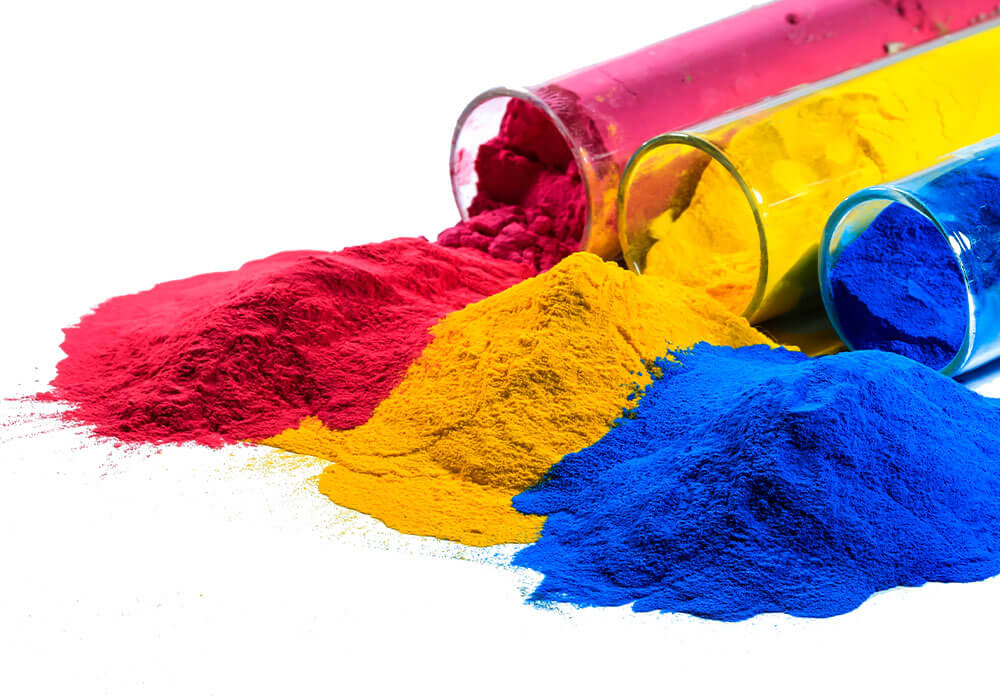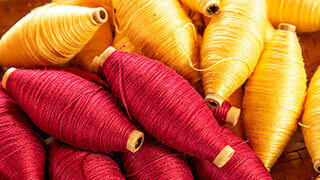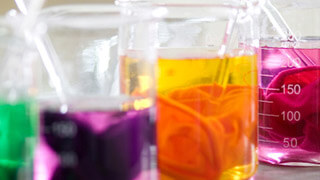Dyeing Basics
Dyes
Dyes are highly colored substances that can be applied to a substrate to impart color with some degree of permanence.
Color is described by several attributes:
- Hue – Basic color and cast
- Value – Lightness or darkness
- Chroma – Strength or amount of hue
To produce various shades most dye formulas are combinations of three dyes and result from a precise mix of some sort of red, yellow, and blue.
Dyeing Basics

Dye Color Perception
How the color of a dye is perceived is dependent on three things:
- Object (may be a fiber, a yarn, fabric, or even a garment)
- Type of illumination or lighting
- Observer (may be a person or an instrument such as a spectrophotometer)
As two people at different locations, the supplier and the customer may try to emulate a standard shade given by a supplier. They think they are looking at the same object but they may not be because the light or illumination may be different. So standardized lighting sources should be used. To take the bias out of an individual observation, computer shade matching can be employed because a shade can be issued a set of numerical values and stored in the computer, there is less handling of the fabric and various light sources can be used to compare under different conditions. There is more to dyeing than obtaining the desired shade—the color must be durable and the dye must exhibit good fastness to future wet treatments and it is critical that the color be consistent from yard to yard, piece to piece, lot to lot, and from lab to production.
Basic Dyeing Principles
Dyeing a substrate involves several basic stages or steps. First, a substrate is placed in a medium, most often water, to which dyestuffs and auxiliary chemicals have been added. Dyes are then adsorbed to the surface of the substrate and slowly diffuse into the fiber. Once inside the fiber, dyes migrate (or level out) and are then fixed to the fiber.
Dyeing a Substrate
In the initial phase, a substrate is placed in a medium, most often water, to which dyestuffs and auxiliary chemicals have been added. Dyes are adsorbed to the surface of the substrate and diffuse into the fiber.
Once inside, dyes level out and are then are fixed to the fiber. To increase colorfastness and obtain consistent shades, some type of after scouring or clean up is required to get the unfixed dye off the surface of the substrate. When you watch a dye bath in progress, you can see how the substrate becomes darker in shade while the bath becomes clearer and lighter. The absorption and diffusion of dye is also known as the exhaustion of the dye.
Dyestuff
Which dyestuff you choose depends on the desired look (shade, color gamut, brightness) and any application issues (process flexibility, cycle time) you may experience.
Fiber-Reactive Dyes
Fiber-reactive dyes form strong covalent bonds with cellulosic fibers, which result in good wash fastness. Reactive dyes are subject to hydrolysis, which is the chemical reaction of the dye with the water. Hydrolysis must be controlled for dye optimization.
A wide range of reactive dye chemistries is available, resulting in a range of performance attributes.
Direct Dyes
Direct dyes are commonly used for cotton. Direct dyes are easy to apply, so dye cycles tend to be short and economical, and a wide range of colors can be applied. However, direct dyes have limited brightness and poor chlorine fastness, and they require after-treatments to achieve adequate wash fastness.
Because direct dyes are attached to cotton fiber by weak forces, they are very sensitive to temperature during the dyeing process. Direct dyes are especially useful for pastel shades and lightfastness.
Vat Dyes
Vat dyes have no initial affinity for cotton and need to be changed chemically (or reduced) to make them soluble and able to adsorb to and diffuse into the fiber.
Once inside the fiber, vat dyes are oxidized back into an insoluble form.
In contrast to direct dyes, vat dyes produce good wash fastness.
Sulfur Dyes
Sulfur dyes are similar to vat dyes in that they have to be made soluble before they can be applied. Compared with vat dyes, they are easier to reduce but harder to oxidize.
Sulfur dyes tend to be inexpensive, but are sensitive to chlorine and are subject to color loss with abrasion, which leads to poor crock fastness. Lightfastness is poor for the light shades but good for the darker shades. Sulfur dyes are widely used for navy blue and dull green shades and are the industry standard for black.
Benefits
- Inexpensive
- Lightfastness is good for darker shades
Drawbacks
- Poor crockfastness
- Lightfastness is bad for lighter shades
Pigments
Pigments are totally insoluble in water, show no affinity to any fiber, and do not penetrate the fiber. They are used to apply color to the surface of a fabric or garment, typically by printing.
Pigments must be applied with a binder. However, too much binder can ruin the feel or hand of the fabric.
Pigments allow for the production of intense fluorescent colors. Fabrics colored with pigments have good lightfastness and are not sensitive to chlorine.



